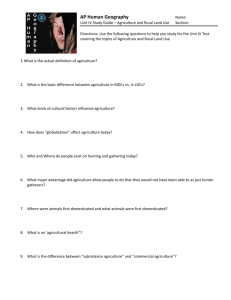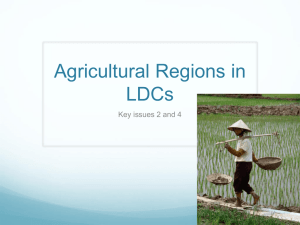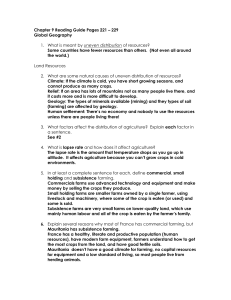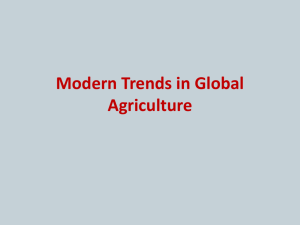Chapter 10 Rubenstein Food Supply
advertisement
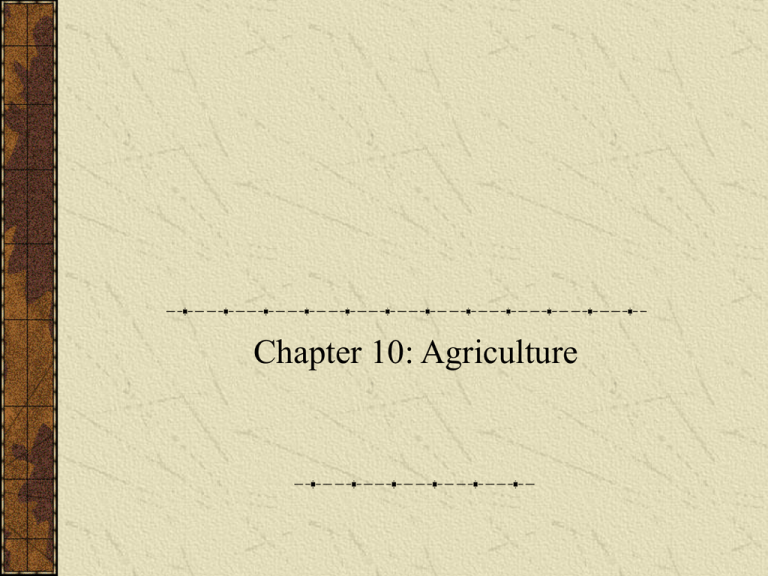
Chapter 10: Agriculture Key Issue I: Where did agriculture originate? Origins of Agriculture Agriculture – deliberate modification of Earth’s surface through cultivation of plants and rearing of animals for sustenance or economic gain Crop – any plant cultivated by people Hunters and Gatherers quarter million people today or .005 of population live in isolated locations, i.e. African Bushmen and Aborigines live in periphery of world settlement Origins of Agriculture cont… Invention of Agriculture accidentally/ trial and error animals for religious ceremonies Two Types of Cultivation vegetative planting – direct cloning Seed agriculture – annual planting (practiced by most farmers today) B. Location of Agricultural Hearths Location of First Vegetative Planting started in southeast Asia and diffused to China and Japan, westward to India, tropical Africa, and the Mediterranean Dog, pig, and chicken probably first domesticated in Southeast Asia other vegetative hearths are in West Africa and South America Location of First Seed Agriculture western India, northern China, and Ethiopia India to southwest Asia • first to integrate seed and animal domestication Locations of First Seed Agr. Cont… C. Diffusion of Seed Agriculture see image C. Classifying Agricultural Hearths Fundamental differences exist b/t MDCs and LDCs LDCs are generally subsistence MDCs practice commercial agr. Five Features distinguish commercial from subsistence farming. Purpose of Farming • LDCS produce food for individual use • MDCS grow crops and raise animals for sale to food processing companies Percentage of Farmers in the Labor Force • LDCS – more than half in labor force • MDCS – less than 1/10 in labor force • US and Canada only 2% of labor force – still produces a food • Dramatic decline of MDC farmers in 20th century US 6 million in 1940 now 2 million push and pull factors responsible for decline surplus of Five Features of Farming cont… Use of Machinery • All iron plow 1770s • 19th – 20th centuries: tractors, combines, corn pickers, and planters. • Transportation Improvements railroads, high-ways, trucks, and refrigeration Scientific advances – fertilizers, herbicides, pesticides, hybrids, animal breeds, etc. Electronics – GPS Farm Size Five Features of Farming Cont… Farm Size 444 acres in US commercial farms 98% of US commercial farms are family owned US 29,000 largest farms avg. more than 3,000 acres and produce revenues of $3 million or $1,000/acre • 1.4% of US farms and 48% of agr. Sales • 50% of US farms less than $5,000 per years and $50/acre US has 60% fewer farms and 85% fewer farmers in 2000 than in 1900 US has been losing prime agricultural land to urban sprawl Five Features of Farming Cont… Relationship to Other Businesses Agribusiness • Commercial farming utilizes modern communications and tech. to keep track of prices, yields, and expenditures • Farmers are 2% of labor force • 20% of US labor works in food related businesses Mapping Agricultural Regions Whittlesey’s 11 agr. Regions (climate regions) Subsistence Agriculture (LDCs) • • • • Shifting cultivation Intensive subsistence, wet rice dominant Intensive subsistence, wet rice not dominant Pastoral nomadism Commercial Agriculture (MDCs) • • • • • • Mixed crop and livestock Dairy Grain Livestock ranching Meditteranean Commercial Gardening Plantation and no agriculture Cultural Practices (alcohol avoidance) Where Are Agricultural Regions in Less Developed Countries? Shifting Cultivation Practiced in Humid Low-Latitude, high temperatures and abundant rainfall • Amazon, Central/West Africa, and Southeast Asia Two Hallmarks • Slash and burn agr. (swidden) • Plant and fallow system Crops Food Supplies Over the Last 200 Years A. Malthus’ prediction – (pop. & food supply) - he was wrong – technological innovations, new farm land, and crop transplants B. Reasons for Increased Supplies 1. Added croplands, transplant of crops to new areas (i.e. corn and maize) 2. New cropland - new lands opened by irrigation 3. Transportation and storage - faster and larger refrigeration methods, protects against spoilage and pests 4. Green revolution - as applied to agriculture not environment (better varieties, higher yields) C. Technological advances – fertilizers, pesticides & The World of Agriculture pg. 323 Current Production of Potatoes and Rice pg. 324 II. Agriculture Today (re-write) A. Success dependent on Geography B. Hunter-gatherers – still exist in small groups C. Subsistence agriculture - Food for self and family, large amount of labor, minimal technology 1. Polyculture gives way to monoculture crops D. Commercial agriculture - food for sale (food co.) 1. Little labor, much capital investment in technology, Polyculture Raising a variety of crops Monoculture Specializing in one type Subsistence and Commercial Agriculture Subsistence Traits Relies mostly on human labor – little animal or machine power Low technology use Smaller average farm size Most food is consumed by farmer Commercial Traits Relies on capital investment in machinery, chemicals, improved seeds Large average farm size Products sold to agribusiness companies Fewer family owned farms Subsistence vs. Commercial Agr. Types of Agriculture A. Defined by five variables 1. Natural environment 2. Crops that are most productive in that environment 3. Degree of technology used 4. Market orientation 5. . Raised for human or animal consumption 10 Categories of Agriculture Irrigated Nomadic herding Low tech subsistence Intensive rice Asian mixed cereals/pulses Mixed farming with livestock Prairie cereals Ranching Mediterranean grains fruits and vegetables Plantation agriculture Types of Agriculture Cont… Irrigated Includes many farming styles from subsistence to intensive production Nomadic herding Pastoral nomads Depend on animals Animals sold or consumed 12-15 million nomads today Government settlement Types of Agriculture Cont… Low-tech subsistence Slash-and-burn Swidden = “to singe” Amazon, Central and West Africa Supports low levels of population Intensive rice farming East, South and Southeast Asia Work done by hand Wet rice important source of food Sawah Double cropping Types of Agriculture Cont… Asian mixed cereal and pulse farming Interior India and northeast China Wheat and barley Pulses = pea or legume family Mixed farming with livestock Usually commercial Crops fed to livestock Dominant in most of world Mixed farming in the “corn belt” Production of Oats, Barley, and Rye pg. 329 World Maize Production pg. 325 Types of Agriculture Cont… Prairie cereals Large scale commercial grain production Wheat Areas of concentration in North America • Winter wheat belt • Spring wheat belt • Palouse region Ranching Commercial grazing Arid or semiarid land Cattle – North and South America Sheep – Australia World Wheat Production pg. 330 Agricultural Productivity pg. 332 Types of Agriculture Cont… Mediterranean Mediterranean climates Hot dry summers, cool rainy winters Most crops for human consumption Olives, grapes, fruits and vegetables Plantation Large commercial farm Latin America, Asia, Africa Coffee, sugarcane, bananas, rubber Determining Productivity Capital investment Technology Equipment Fertilizers/pesticides Irrigation Natural environment Technology and capital investment lessens the importance Livestock Grain consumption Direct and indirect Per capita consumption of meat Problems with animal production Environmental Dairy farming Value added by manufacturing Future Food Supplies New crop potential Preserving genetic diversity Cultural acceptance Scientific revolution Gene splicing Genetically modified (GM) Cloning Resistance to biotechnology Religious / cultural / environmental Global warming Distribution of Supplies and Production Poor distribution Hunger/famine Political strife Countries import and export food Increase in production Improvement in distribution Problems Increasing Food Production Diminishing returns of fertilizers Financial incentives Pricing controls Taxes Land ownership Concentration of ownership Collective farming/ Communism Commercial cash crops in developing countries Leading to economic self sufficiency? Illegal drugs Policies of Wealthy Countries High tariffs to protect markets Farm subsidies Encourage surpluses in rich areas Decrease production in poor areas Impact on world market Subsidies: Reasons & Results Reasons Protects farmers National security Tradition Political Results Low price Restricts competition Effect on trade and production Fish Harvest Traditional fishing Physical and financial risks Small fraction of global catch Modern fishing Fisheries Overfishing and depletion Increasing regulation Aquaculture Herding and domesticating aquatic species Fertilizer production End of Chapter 8
